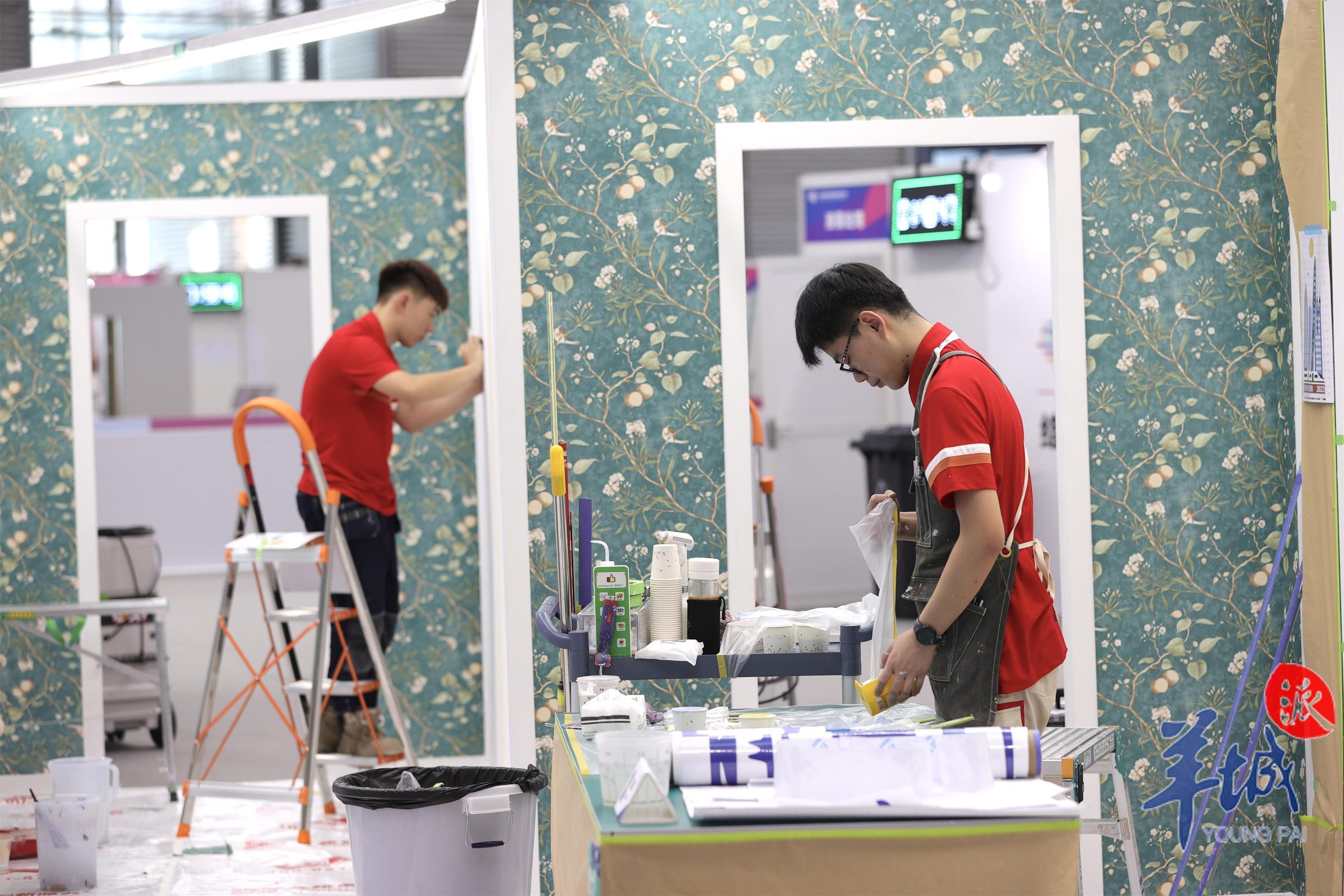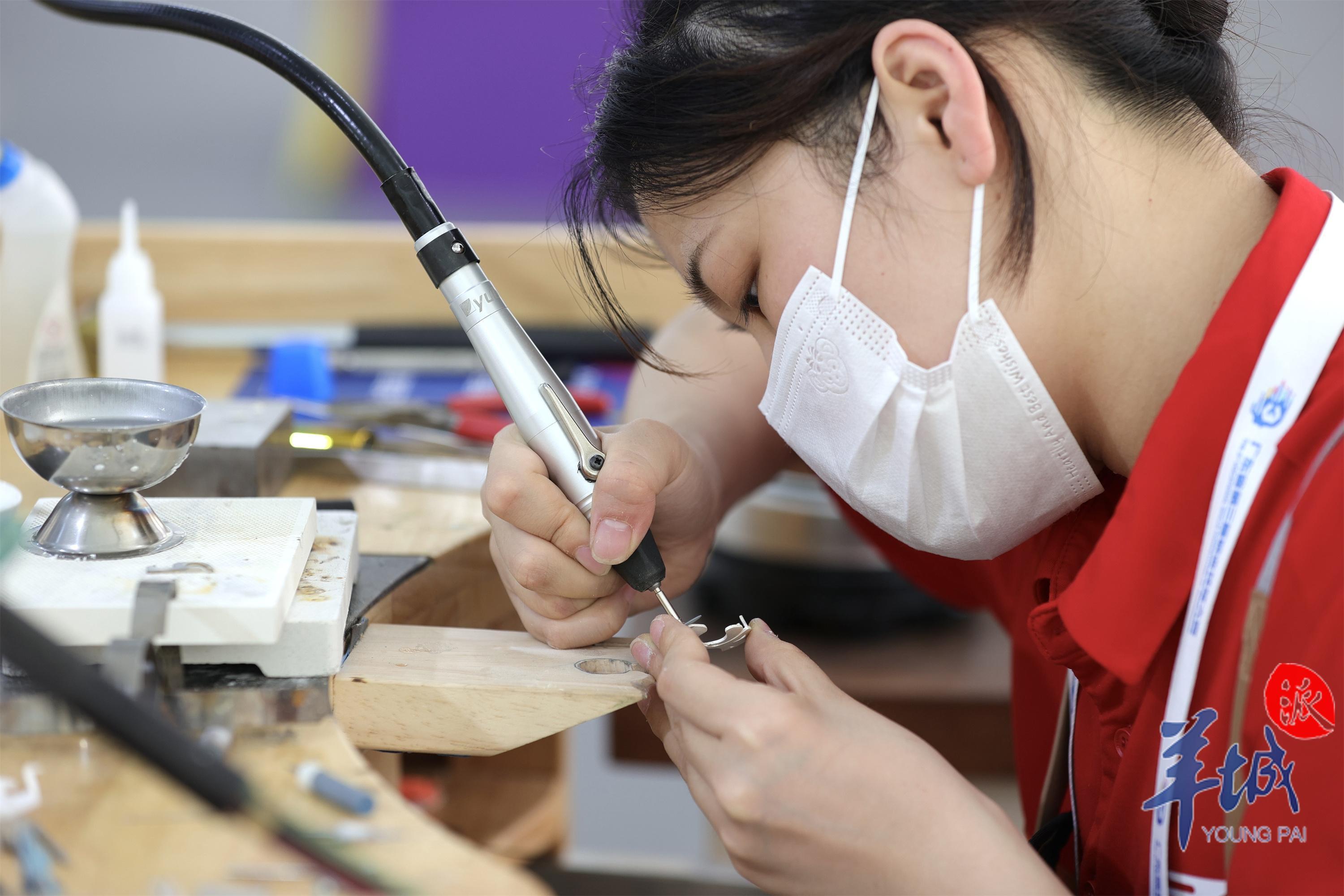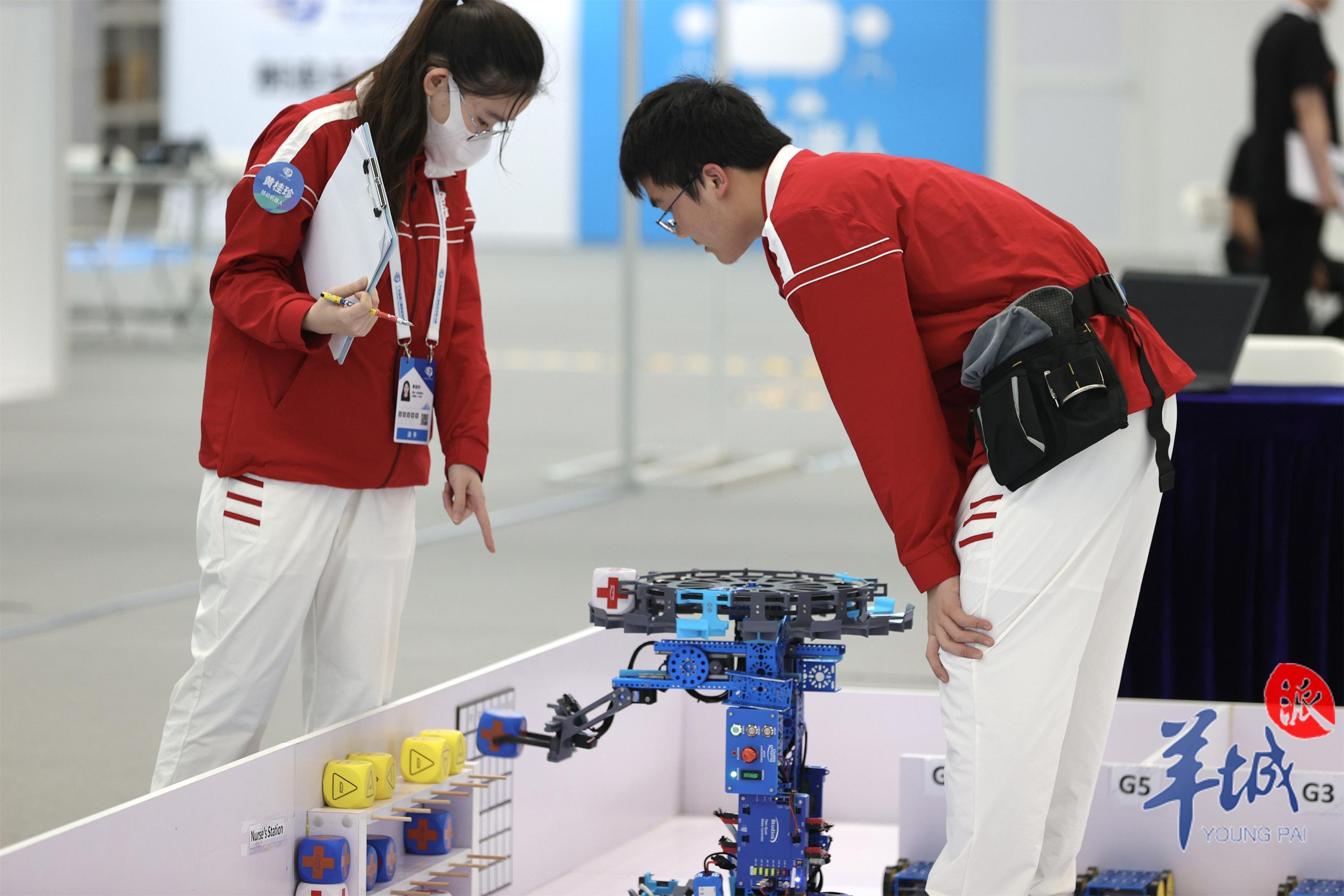
Several strategic industry competition projects caught the eyes of the public in the Third Guangdong Vocational Skills Contest on May 19th, the second day of the ongoing competition. There are exquisite gemstone pendants, mobile robots for sorting and carrying, unmanned assembly lines, 3D printing and more at the event. Contestants on site presented their technical skills by using their brains and physical strength to create one delicate and exquisite piece after another.
Jewelry processing: Error handmade less than 0.02 millimeters
In the competition of jewelry processing, the sound of jewelry polishing could be heard constantly, and the contestants are working attentively on processing, cutting, and piecing together precious metal plates.
This project requires highly manual production. The competition question for the round is "Chun Ye Xi Yu". Contestants should complete a gemstone pendant that is 4.77 cm high and 3.4 cm wide within 18 hours, at a rate of 6 hours per day. Judge Zou Ningxin introduced, "The difficulty lies in precision since the error between the actual size and the drawing cannot exceed 0.02 millimeters, which is even thinner than a human hair."

Today, jewelry processing develops into two major trends. One is exquisite craftsmanship, which means crafts become increasingly complex. The other is personalization, which has given rise to private customization due to different market demands. This suggests that the requirements for contestants this time are becoming increasingly high.
Creating mobile robots for drug delivery and hazardous material handling
In addition to precision, there are many projects concerning intelligent modernization at the contest, among which is the mobile robot project.
Contestants on the scene are busy assembling robots. The competition field is divided into several areas of 8 square meters for simulating scenes such as drug dispensing in hospitals, nurse stations, wards, and hazardous material handling.

It is reported that contestants in the mobile robot project cooperated in pairs in completing the design, assembly, and control of the robots to perform specified tasks such as grabbing objects and moving.
"The competition for mobile robots lasts for three days. On the first morning, contestants mainly build and debug their robots, and in the afternoon, they need to complete 12 test questions," said the judge Zhang Anfu. These 12 test questions are used to evaluate the core performance of the built robots, and the second and third days will involve demonstrations of two comprehensive tasks, including distributing drugs to different wards or collecting hazardous materials.
"If manual labor, as usual, is relied upon for handling and sorting goods, there will be an enormous labour cost incurred and workers making mistakes after intensive work. However, these robots can solve the problems," said Zhang Anfu, adding that students and project participants in this professional field have employment competitive edges in e-commerce, warehousing, logistics, and other industries.
珠宝加工误差细过头发丝!看技能英豪省赛“献技”
5月19日,广东省第三届职业技能大赛(以下简称“省赛”)集中赛开赛第二天,多个战略性产业比赛项目吸引了众人目光。精美绝伦的宝石吊坠、会分拣搬运的移动机器人、无人流水线、3D打印……赛场上,选手们将技能发挥到极致,靠脑力与体力,以及十根巧指打磨着一件又一件精细绝美的作品。
珠宝加工:手工误差不能超过0.02毫米
走进珠宝加工项目比赛现场,能听到阵阵打磨珠宝的嗞嗞声,选手们正聚精会神地对贵金属板进行加工、切割、拼接。
这个项目要求纯手工制作。此次比赛试题为《春夜喜雨》,选手要在18个小时内,以每天6小时的速度,完成一个高4.77厘米、宽3.4厘米的宝石吊坠。裁判长邹宁馨介绍,“难就难在精细度,实物尺寸与图纸的误差不能超过0.02毫米,这比头发丝还细。”
如今珠宝加工发展呈现两大特点,一是精美化,工艺越来越复杂;另一个是个性化,不同市场需求催生了“私人订制 ”。这意味着对选手们的要求也越来越高。
移动机器人:打造送药、危险品处理医用机器人
在职业技能大赛上,除了比精度外,还有许多与智能现代化相关的项目,其中,移动机器人项目就是其一。
在移动机器人项目比赛现场,选手们正在忙碌地组装机器人,比赛场地划分成一块块2m×4m的区域,模拟医院分药场景,分成护士站、病房、危险品处理等区域。
据悉,移动机器人项目的选手需两人一组、分工配合进行比赛,完成移动机器人的设计、组装,控制机器人进行抓取物体、移动等指定任务动作。
“移动机器人项目比赛持续三天,第一天上午的时间主要是选手搭建、调试参赛机器人,下午需要完成12道赛题的测试。”该项目裁判章安福介绍。12道赛题是为了评估搭建的机器人的核心性能,第二、第三天将进行两个综合任务的演示,包括为不同病房分配药物或回收危险品等任务。
“如果像往常一样,依靠人力进行货物的搬运、分拣,不仅需要投入大量的人力成本,而且高强度工作后,工人也容易出错。但使用机器人,就不存在这个问题。” 章安福表示,这一专业的学生与项目选手,在电商、仓储、物流等行业企业都具有就业优势。
文|羊城晚报全媒体记者 周聪 沈婷婷
图|羊城晚报全媒体记者 王磊
翻译|陈萱
责编|王瑜瑛









